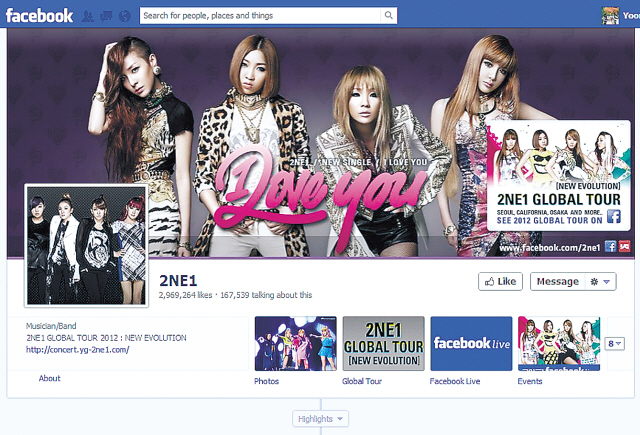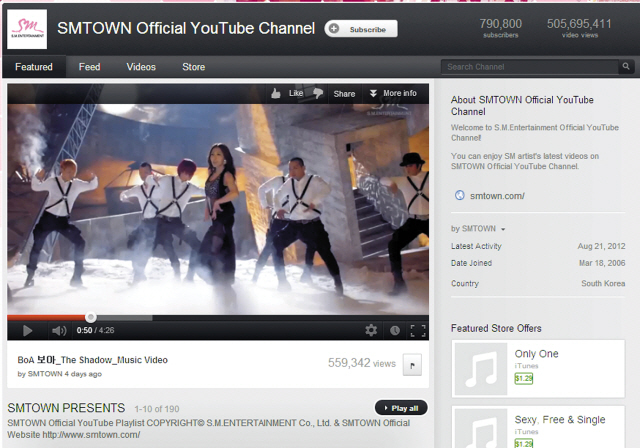Successful social marketing translates into profits for K-pop acts
By Korea HeraldPublished : Aug. 24, 2012 - 20:43
Amateur but powerful social media users boost global buzz over Korean Wave
The local social media market in Korea is relatively closed off from the outside world, making it difficult for non-Korean Internet or mobile users to search for anything related to K-pop in the English language.
Using local social media services ― such as Cyworld, the Korean version of Facebook, or Me2day, the Korean version of Twitter ― it is almost impossible to search for English content on K-pop or hallyu.
However, as Korean artists recently started to move away from local SNS to more open and global SNS such YouTube, Twitter and Facebook, the Korean Wave shifted gear “from fad to phenomena,” said an industry expert.
“The Internet became synonymous with going international. ‘Popularity’ of a music artist is no longer measured purely by sales figures or airplay rotations but also views, tweets, and like,” said Bernie Cho, president of DFSB Kollective, a creative content group that also distributes K-pop digitally to iTunes.
The local social media market in Korea is relatively closed off from the outside world, making it difficult for non-Korean Internet or mobile users to search for anything related to K-pop in the English language.
Using local social media services ― such as Cyworld, the Korean version of Facebook, or Me2day, the Korean version of Twitter ― it is almost impossible to search for English content on K-pop or hallyu.
However, as Korean artists recently started to move away from local SNS to more open and global SNS such YouTube, Twitter and Facebook, the Korean Wave shifted gear “from fad to phenomena,” said an industry expert.
“The Internet became synonymous with going international. ‘Popularity’ of a music artist is no longer measured purely by sales figures or airplay rotations but also views, tweets, and like,” said Bernie Cho, president of DFSB Kollective, a creative content group that also distributes K-pop digitally to iTunes.


“K-pop’s success on social media is now translating online busyness into offline business opportunities for Korean idol acts on tours and indie acts at festivals.”
If a K-pop music video attracts more than 1 million views, for example, it will generate “a meaningful revenue” big enough to dole out profits to members of a K-pop group, Cho said. However, he declined to comment on what percentage the entertainment agency or K-pop acts get from YouTube ads out of the total sales overseas.
An example in turning online fever into offline tours is 16-year-old guitarist Jung Sung-ha, whose YouTube videos have garnered more than 521 million views as of Wednesday.
Jung’s yearly schedule is already full with world tours, local city tours and collaborations with K-pop groups under YG Entertainment.
Among major entertainment agencies, S.M. Entertainment was the first to build a strategic partnership with YouTube and join the most-visited video site channel under the name S.M. Town in August 2006. YG Entertainment followed suit in January 2008, and JYP Entertainment, in December 2008.
The three major entertainment agencies continued to open other social media channels including Facebook pages, interacting with fans around the world on a real-time basis.
Before the agencies unveil their K-pop artists’ music video or digitized music files online, they release teaser videos and photos on social media platforms so that the anticipation of the fans for upcoming K-pop music can be maximized.
“Several years ago when we first created our official channel on YouTube, we thought K-pop music videos would easily resonate with global fans if they had quality content. And in hindsight, our strategy worked perfectly,” said Kim Eun-a, spokesperson for S.M. That was when the K-pop started to make a meaningful impact on the global market, she said.
David Cho, marketing team head of the music business division at CJ E&M, said the key to successful K-pop social marketing is “crowdsourcing,” allowing all global internet users to voluntarily participate in the process of content production.
“Should the K-pop social media marketing become truly successful, content providers will have to carefully screen out politically-incorrect content such as issues of race, religion and gender,” Cho said.
“Crowdsourcing will bring about interactive communication between producers and consumers where producers can reflect the interests and ideas of the masses in their creative products,” he said.
Even if Korean artists and producers are good at dealing with social media, it was not major broadcasters or professional agencies but amateur fans who actually helped exemplify the viral power of K-pop, according to a report by Park Han-woo, associate professor in Yeungnam University’s media and communication department.
Park’s analysis report tracking the Twitter network of K-pop from Nov. 1 to Feb. 15 showed that regions including Asia, America and Europe had their major “network hubs” for K-pop created by ordinary Twitter users, bloggers and hallyu websites.
In Europe, Twitter user Nela Panghy-Lee, a German model, was the most powerful in spreading K-pop news, the report found. In Japan, a Twitter user with id “kpop_lov” was the major hub of K-pop information, whereas a hallyu blog “dkpopnews.net” contributed to the spread of K-pop the most in Southeast Asia.
By Kim Yoon-mi (yoonmi@heraldcorp.com)
-
Articles by Korea Herald











![[Hello India] Hyundai Motor vows to boost 'clean mobility' in India](http://res.heraldm.com/phpwas/restmb_idxmake.php?idx=644&simg=/content/image/2024/04/25/20240425050672_0.jpg&u=)








